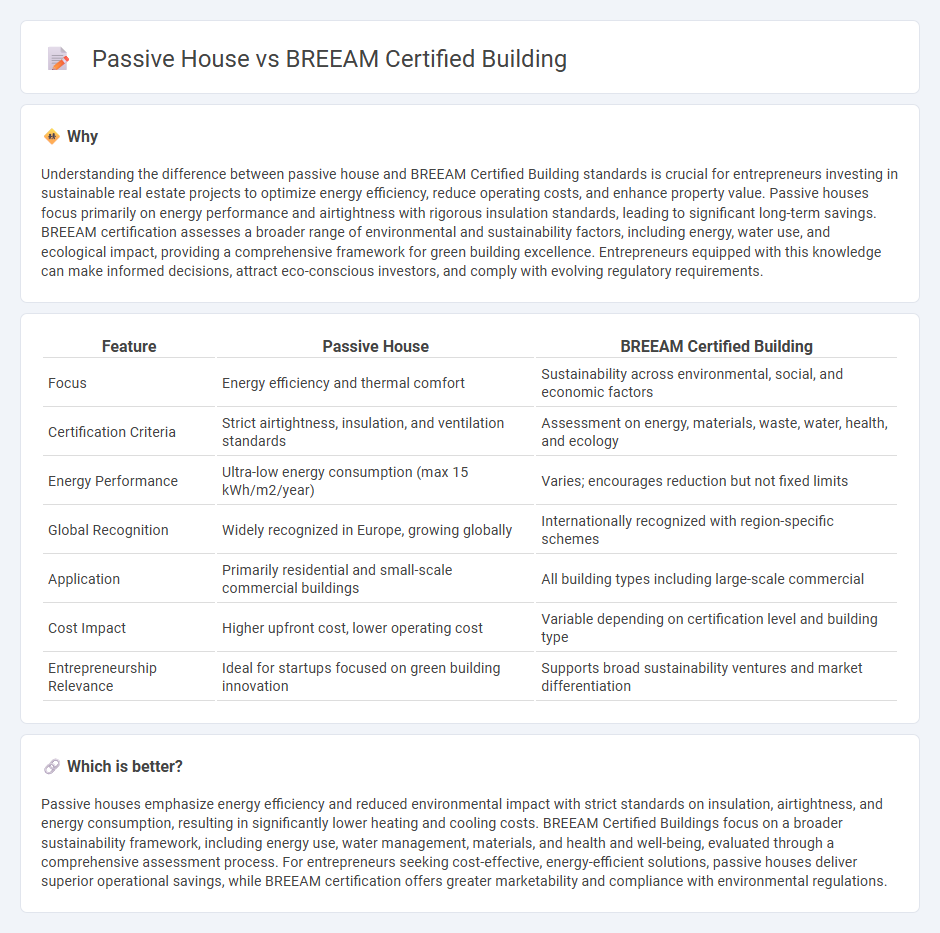
Entrepreneurship in sustainable construction increasingly focuses on Passive House and BREEAM Certified Buildings, both leading standards for energy efficiency and environmental performance. Passive House emphasizes ultra-low energy use through rigorous insulation and airtightness, while BREEAM assesses broader sustainability criteria including resource management and occupant health. Explore the distinct benefits and opportunities these certifications offer to innovative entrepreneurs in green building.
Why it is important
Understanding the difference between passive house and BREEAM Certified Building standards is crucial for entrepreneurs investing in sustainable real estate projects to optimize energy efficiency, reduce operating costs, and enhance property value. Passive houses focus primarily on energy performance and airtightness with rigorous insulation standards, leading to significant long-term savings. BREEAM certification assesses a broader range of environmental and sustainability factors, including energy, water use, and ecological impact, providing a comprehensive framework for green building excellence. Entrepreneurs equipped with this knowledge can make informed decisions, attract eco-conscious investors, and comply with evolving regulatory requirements.
Comparison Table
| Feature | Passive House | BREEAM Certified Building |
|---|---|---|
| Focus | Energy efficiency and thermal comfort | Sustainability across environmental, social, and economic factors |
| Certification Criteria | Strict airtightness, insulation, and ventilation standards | Assessment on energy, materials, waste, water, health, and ecology |
| Energy Performance | Ultra-low energy consumption (max 15 kWh/m2/year) | Varies; encourages reduction but not fixed limits |
| Global Recognition | Widely recognized in Europe, growing globally | Internationally recognized with region-specific schemes |
| Application | Primarily residential and small-scale commercial buildings | All building types including large-scale commercial |
| Cost Impact | Higher upfront cost, lower operating cost | Variable depending on certification level and building type |
| Entrepreneurship Relevance | Ideal for startups focused on green building innovation | Supports broad sustainability ventures and market differentiation |
Which is better?
Passive houses emphasize energy efficiency and reduced environmental impact with strict standards on insulation, airtightness, and energy consumption, resulting in significantly lower heating and cooling costs. BREEAM Certified Buildings focus on a broader sustainability framework, including energy use, water management, materials, and health and well-being, evaluated through a comprehensive assessment process. For entrepreneurs seeking cost-effective, energy-efficient solutions, passive houses deliver superior operational savings, while BREEAM certification offers greater marketability and compliance with environmental regulations.
Connection
Entrepreneurship in sustainable construction often involves developing Passive House and BREEAM certified buildings, which prioritize energy efficiency and environmental performance. Passive House standards focus on minimizing energy use for heating and cooling, while BREEAM certification assesses a building's overall sustainability impact, including material sourcing and waste management. Combining both approaches attracts eco-conscious investors and tenants, driving innovation and profitability in green building ventures.
Key Terms
Energy Efficiency
BREEAM certified buildings incorporate rigorous sustainability criteria, including energy efficiency standards, to reduce environmental impact and operational costs by optimizing building design, materials, and systems. Passive houses prioritize ultra-low energy consumption through high insulation, airtightness, and heat recovery ventilation, achieving significant reductions in heating and cooling demand. Explore the detailed energy performance metrics and certification benefits to determine the best solution for your building project.
Sustainability Standards
BREEAM-certified buildings adhere to rigorous environmental performance criteria across energy efficiency, water usage, and indoor environmental quality, achieving sustainability through comprehensive assessment frameworks. Passive houses prioritize ultra-low energy consumption by implementing stringent insulation, airtightness, and ventilation standards, resulting in minimal operational carbon emissions. Explore in-depth comparisons of sustainability standards to understand which certification best aligns with your green building goals.
Performance Criteria
BREEAM Certified Buildings emphasize sustainability through a comprehensive assessment of energy efficiency, water usage, indoor environmental quality, and materials, aiming to reduce environmental impact across the building lifecycle. Passive Houses prioritize ultra-low energy consumption by optimizing insulation, airtightness, and ventilation, achieving superior thermal comfort and minimal heating demand. Explore detailed comparisons of energy performance, certification processes, and environmental benefits to determine the best fit for your sustainable building goals.
Source and External Links
BREEAM - Wikipedia - BREEAM (Building Research Establishment Environmental Assessment Method) is the world's longest established sustainability assessment method for buildings, with around 550,000 buildings certified, focusing on energy, water, health, pollution, transport, materials, and waste to rate buildings from "Pass" to "Outstanding".
BREEAM certification from BRE - BRE Group - BREEAM is a third-party certification system that improves sustainability in building projects from design to use, offering various schemes like New Construction and Refurbishment, enabling environmental and social governance and net zero goals.
What is BREEAM?: How the first green building standard works - BREEAM is a rigorous, science-based green building certification operating in 85 countries that evaluates holistic sustainability factors such as ecosystem impact, carbon emissions, occupant wellbeing, energy efficiency, and climate resilience.
 dowidth.com
dowidth.com